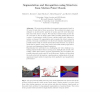Free Online Productivity Tools
i2Speak
i2Symbol
i2OCR
iTex2Img
iWeb2Print
iWeb2Shot
i2Type
iPdf2Split
iPdf2Merge
i2Bopomofo
i2Arabic
i2Style
i2Image
i2PDF
iLatex2Rtf
Sci2ools
ECCV
2008
Springer
2008
Springer
Segmentation and Recognition Using Structure from Motion Point Clouds
We propose an algorithm for semantic segmentation based on 3D point clouds derived from ego-motion. We motivate five simple cues designed to model specific patterns of motion and 3D world structure that vary with object category. We introduce features that project the 3D cues back to the 2D image plane while modeling spatial layout and context. A randomized decision forest combines many such features to achieve a coherent 2D segmentation and recognize the object categories present. Our main contribution is to show how semantic segmentation is possible based solely on motion-derived 3D world structure. Our method works well on sparse, noisy point clouds, and unlike existing approaches, does not need appearance-based descriptors. Experiments were performed on a challenging new video database containing sequences filmed from a moving car in daylight and at dusk. The results confirm that indeed, accurate segmentation and recognition are possible using only motion and 3D world structure. Fu...
Accurate Segmentation | Cloud Automatic Segmentation | Coherent 2D Segmentation | Computer Vision | ECCV 2008 | Noisy Point Clouds | Semantic Segmentation |
| Added | 15 Oct 2009 |
| Updated | 15 Oct 2009 |
| Type | Conference |
| Year | 2008 |
| Where | ECCV |
| Authors | Gabriel J. Brostow, Jamie Shotton, Julien Fauqueur, Roberto Cipolla |
Comments (0)

